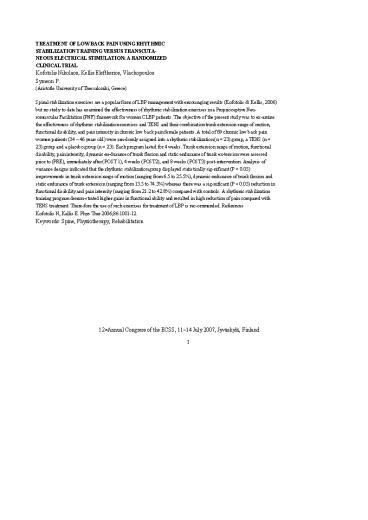TREATMENT OF LOW BACK PAIN USING RHYTHMIC - PowerPoint PPT Presentation
1 / 1
Title:
TREATMENT OF LOW BACK PAIN USING RHYTHMIC
Description:
Spinal stabilization exercises are a popular form of LBP management with ... disability, pain intensity, dynamic en-durance of trunk flexion and static ... – PowerPoint PPT presentation
Number of Views:57
Avg rating:3.0/5.0
Title: TREATMENT OF LOW BACK PAIN USING RHYTHMIC
1
TREATMENT OF LOW BACK PAIN USING RHYTHMIC
STABILIZATION TRAINING VERSUS TRANSCUTA- NEOUS
ELECTRICAL STIMULATION A RANDOMIZED CLINICAL
TRIAL Kofotolis Nikolaos, Kellis Eleftherios,
Vlachopoulos Symeon P. (Aristotle University of
Thessaloniki, Greece) Spinal stabilization
exercises are a popular form of LBP management
with encouraging results (Kofotolis Kellis,
2006) but no study to date has examined the
effectiveness of rhythmic stabilization exercises
in a Proprioceptive Neu-romuscular Facilitation
(PNF) framework for women CLBP patients. The
objective of the present study was to ex-amine
the effectiveness of rhythmic stabilization
exercises and TENS and their combination trunk
extension range of motion, functional disability,
and pain intensity in chronic low back pain
female patients. A total of 69 chronic low back
pain women patients (34 46 years old) were
ran-domly assigned into a rhythmic stabilization
(n 23) group, a TENS (n 23) group and a
placebo group (n 23). Each program lasted for 4
weeks. Trunk extension range of motion,
functional disability, pain intensity, dynamic
en-durance of trunk flexion and static endurance
of trunk ex-tension were assessed prior to (PRE),
immediately after (POST 1), 4 weeks (POST2), and
8 weeks (POST3) post-intervention. Analysis of
variance designs indicated that the rhythmic
stabilization group displayed statistically
sig-nificant (P lt 0.05) improvements in trunk
extension range of motion (ranging from 6.5 to
25.5), dynamic endurance of trunk flexion and
static endurance of trunk extension (ranging from
13.5 to 74.3) whereas there was a sig-nificant
(P lt 0.05) reduction in functional disability and
pain intensity (ranging from 21.2 to 42.8)
compared with controls. A rhythmic stabilization
training program demon-strated higher gains in
functional ability and resulted in high reduction
of pain compared with TENS treatment. There-fore
the use of such exercises for treatment of LBP is
rec-ommended. References Kofotolis N, Kellis E.
Phys Ther 2006861001-12. Keywords Spine,
Physiotherapy, Rehabilitation 12thAnnual
Congress of the ECSS, 1114 July 2007, Jyväskylä,
Finland I































